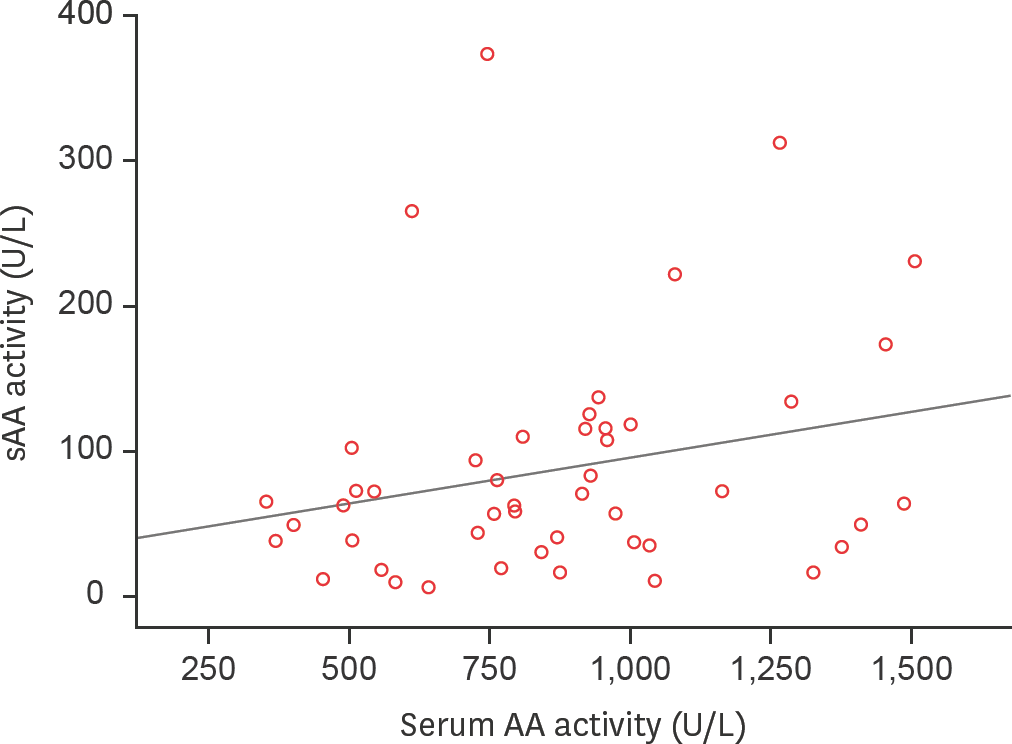Abstract
Salivary alpha-amylase (sAA) is a stress biomarker in human diseases, but there are no reports of sAA measurements in diseased dogs. This study measured the sAA and serum alpha-amylase (AA) levels in 16 healthy dogs and 31 diseased dogs using a kinetic enzyme assay to assess the stress status. The sAA and serum AA levels were significantly higher in the diseased dogs than in healthy dogs (p < 0.05), but there was no correlation between the 2 groups (r = 0.251, p = 0.089). This suggests that sAA can be useful as a stress biomarker in diseased dogs.
References
1. Rohleder N, Nater UM. Determinants of salivary α-amylase in humans and methodological considerations. Psychoneuroendocrinology. 2009; 34:469–485.

3. McEwen BS, Bowles NP, Gray JD, Hill MN, Hunter RG, Karatsoreos IN, Nasca C. Mechanisms of stress in the brain. Nat Neurosci. 2015; 18:1353–1363.

4. Thoma MV, Kirschbaum C, Wolf JM, Rohleder N. Acute stress responses in salivary alpha-amylase predict increases of plasma norepinephrine. Biol Psychol. 2012; 91:342–348.

5. Takai N, Yamaguchi M, Aragaki T, Eto K, Uchihashi K, Nishikawa Y. Effect of psychological stress on the salivary cortisol and amylase levels in healthy young adults. Arch Oral Biol. 2004; 49:963–968.

6. Fuentes-Rubio M, Fuentes F, Otal J, Quiles A, Hevia ML. Validation of an assay for quantification of alpha-amylase in saliva of sheep. Can J Vet Res. 2016; 80:197–202.
7. Contreras-Aguilar MD, Tecles F, Martínez-Subiela S, Escribano D, Bernal LJ, Cerón JJ. Detection and measurement of alpha-amylase in canine saliva and changes after an experimentally induced sympathetic activation. BMC Vet Res. 2017; 13:266.

8. Koh D, Ng V, Naing L. Alpha amylase as a salivary biomarker of acute stress of venepuncture from periodic medical examinations. Front Public Health. 2014; 2:121.

9. Noto Y, Sato T, Kudo M, Kurata K, Hirota K. The relationship between salivary biomarkers and state-trait anxiety inventory score under mental arithmetic stress: a pilot study. Anesth Analg. 2005; 101:1873–1876.

10. Yigla M, Berkovich Y, Nagler RM. Oxidative stress indices in COPD–Broncho-alveolar lavage and salivary analysis. Arch Oral Biol. 2007; 52:36–43.

11. Aydin S. A comparison of ghrelin, glucose, alpha-amylase and protein levels in saliva from diabetics. J Biochem Mol Biol. 2007; 40:29–35.

12. Vangipuram S, Jha A, Bhashyam M. The diagnostic applications of saliva- a review. IOSR J Dent Med Sci. 2016; 15:96–101.
Fig. 1.
Relationship between the sAA and serum AA in all dogs. No correlation was observed between the alpha-amylase activities of the serum and saliva according to Spearman correlation analysis (r = 0.251, p = 0.089). sAA, salivary alpha-amylase; AA, alpha-amylase.





 PDF
PDF ePub
ePub Citation
Citation Print
Print


 XML Download
XML Download